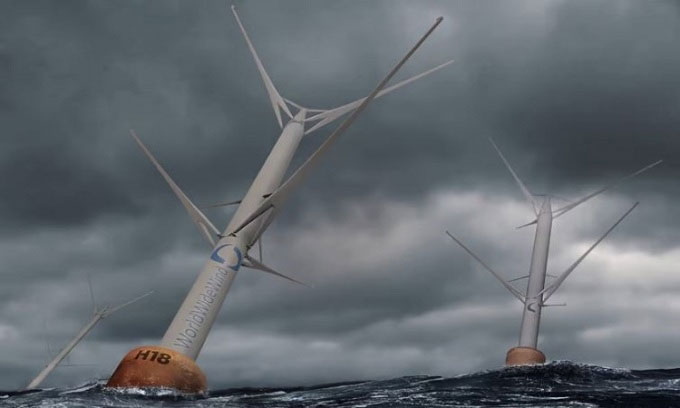Development of a 40 MW . dual-wing floating wind turbine model
The floating turbine design of the company World Wide Wind, Norway, approaches wind energy in a different direction. These vertical axis floating wind turbines (VAWTs) have two sets of blades that rotate in opposite directions, promising more than twice the capacity of today's largest turbines, New Atlas reported on August 30.

The vertical turbine rotates in the opposite direction of the World Wide Wind. (Photo: World Wide Wind)
Some experts and operators consider the VAWT well suited for offshore installations. This type of turbine tends to stay upright and is harder to dump. They can receive wind energy from all directions instead of directly picking it up, helping to reduce the need for bulky components such as horizontal axis turbines.
World Wide Wind introduces an entirely new type of floating VAWT specifically designed for offshore deployment and easy to scale. In fact, it's two VAWTs in one, a lower turbine that is fixed to the outer shell of the pylon and rotates in one direction, the taller turbine attached to the shaft and rotates in the other direction. The company calls this design a counter-rotating vertical turbine (CRVT).
The heaviest and most maintenance-intensive part is the turbine base, below the floating pontoon bridge. But turbines are not designed to be vertical. The tower will tilt with the wind, increasing the resistance to sudden gusts of wind and damage from vibration.
The world's largest wind turbine today is MingYang Smart Energy 16.0-242. With a height of 242 m, this turbine has a design capacity of 16 MW. World Wide Wind says its new turbine model can reach a height of 400 m and a capacity of 40 MW / unit. The company representative said that the expected cost of conductive electricity production (LCoE - cost per unit of energy over the entire average life of the technology) is expected to be nearly 50 USD/MW, less than 1/2. LCoE of offshore wind projects of the US Department of Energy Information will be operational in 2027.
World Wide Wind shares that the company is accelerating the development of CRVT through prototypes. The goal is to put into operation the 3 MW model by 2026 and the completed 40 MW version by 2029. However, finding a location to test the technology in the North Sea is very difficult because there are so many other projects in the pipeline. area.
- Wind turbine balloons
- Revealing the ability to create terrifying lightning of wind turbines
- Ultra-small wind turbine for smartphones
- Successfully built turbine-free turbine
- Design a wind turbine that flies automatically like a kite
- The world's largest wind turbine goes into operation in the UK
- Charge your phone battery with a wind turbine
- World's first floating wind power generation station
- 7,000 km journey to transport 70m wind turbine blades
- Video: Close-up of the giant wind turbine construction process, from digging the foundation to assembling turbine parts
- New technology helps reduce wind power costs
- Device 'strange' exploits the power
 The US company is about to build a supersonic passenger plane of 6,000km / h
The US company is about to build a supersonic passenger plane of 6,000km / h Japan develops avatar robot as in fiction film
Japan develops avatar robot as in fiction film Australia tested the world's first mango picking robot
Australia tested the world's first mango picking robot America develops technology to separate water from animal waste
America develops technology to separate water from animal waste What is the fastest wind speed ever recorded?
What is the fastest wind speed ever recorded?  Hybrid energy raft provides electricity to 1,000 homes per day
Hybrid energy raft provides electricity to 1,000 homes per day  'Small but mighty' turbine generates energy from gentle winds
'Small but mighty' turbine generates energy from gentle winds  What material is the world's largest wind turbine blade made of that is 9 times stronger than steel?
What material is the world's largest wind turbine blade made of that is 9 times stronger than steel?  The strongest wind tunnels in the world
The strongest wind tunnels in the world  The Netherlands built the world's largest floating offshore solar farm
The Netherlands built the world's largest floating offshore solar farm 